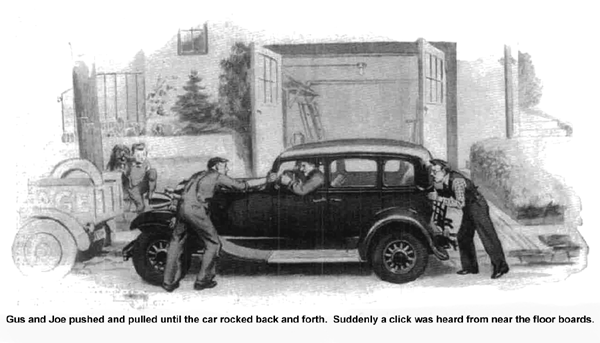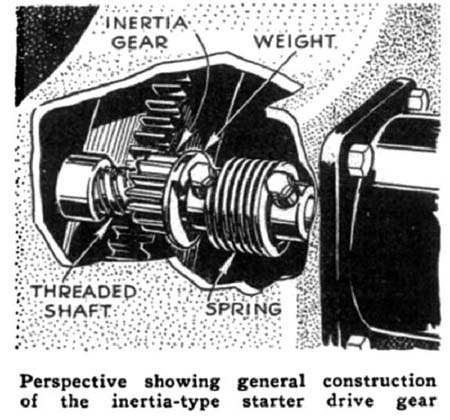December 1934
GUS tells what to do
WHEN YOUR STARTER BALKS
by Martin Bunn
Dave Morrison settled himself behind the steering wheel of his car and jabbed confidently at the starter button. Instead of the expected whine from the motor, there was a metallic clank and a straining groan.
"Now what -- " Dave exclaimed helplessly.
Ned Rogers, who was sitting beside him, scratched his head. "Never heard anything like that before," he confessed.
"Try it again."
But the second try proved no more successful than the first. Only a faint growl was heard. The motor failed to spin.
As a last resort, Dave decided to try the hand crank. "It's no use, Ned," he grunted as he placed his full weight on the crank handle. "I can't even budge her. Seems like she's frozen stiff. You better run on down to the office before you're late. I'll give the Model Garage a ring and see what they have to say."
When Gus Wilson and Joe Clark drove up in the Model Garage wrecker a few minutes later, Dave Morrison's head was buried under the open hood of his car.
"What's the matter?" asked Gus as he swung to the ground. "This cold spell got the best of that motor already?"
Morrison shrugged his shoulders.
"Blamed if I know. One thing is sure, she won't turn over and all the starter does is groan. Here, listen to it," he commanded, climbing into the driver's seat and holding down the starter button.
"Whoa! That's enough!" broke in Gus almost at the first note of the groan.
"Put her in high gear and let up on that emergency brake. I want to try something." As he spoke, he walked to the front of the car and motioned Joe around to the rear.
"Now, have you got her in high?" he asked. Morrison nodded.
"O. K. then, Joe, let's go."
With that, he and Joe began pushing and pulling until the car rocked back and forth in an even swing that almost tossed Morrison from his seat. Suddenly, a loud click resounded from the vicinity of the floorboards.
"There," said Gus, "that ought to fix it. Now put her back into neutral and step on the starter again." This time, the hum of the starter motor told a different story. The very first touch of the button set the motor spinning.
"I'll be hanged!" Morrison cried. "What in blazes was the matter with it anyway?"
Gus chuckled. "Inertia gear was stuck," he replied.
Morrison looked at him blankly, "What was stuck?"
"The drive gear on your starter," explained Gus. "You know how that works, don't you?"
The puzzled frown on Dave Morrison's face showed plainly that he did not know.
"Come around here, then, and I'll show you," said Gus as he unlimbered the side of the hood and selected a wrench from the tool roll Joe had spread out on the running board. "First of all, we'll unscrew these two studs that hold the starter motor in place, loosen these switch connections, and take a good look at what's inside."
As Gus worked at the studs, Joe supported the body of the starter motor.
When the two studs were freed, the motor dropped and Joe carefully pulled its long drive shaft from the hole in the casting that housed the flywheel. The starter looked like any other electric motor except for the shaft projecting at the end.
"See this?" Gus asked, poking the shaft with one end of his wrench. "That's what hooks up the starter motor and the teeth on the flywheel. Inertia drive, it's called. Not every car has one, but yours is one that has."
Dave studied it carefully
"If you'll look," continued Gus, "you'll notice that it's a threaded shaft with a counterweighted gear that runs in the threads. Now when you step on the starter button, the electrical circuit to the starter motor is closed and the threaded shaft turns, but the weighted gear tends to stand still. That screws the gear out on the shaft where it finally meshes with the flywheel teeth and turns the motor.
"Naturally, as soon as the engine starts firing under its own power, the flywheel goes faster than the starter motor spindle. That screws the starter gear backwards on the shaft disengages the teeth, and lets the flywheel run free."
"But what's this spring for?" asked Dave, pointing to a heavy coil half hidden by the starter motor housing.
"That's a sort of shock absorber," explained Gus. "Takes up the sudden jerks when the two gears mesh. Now, to get back to your trouble, for some reason or other, the counterweighted gear on this drive got jammed in the flywheel teeth. It wouldn't release, and it wouldn't let the starter motor turn the flywheel."
"Well, how did rocking the car loosen it?"
"That's simple," Gus said. "With the gears in high, the flywheel jiggled back and forth every time we rocked the car. Gradually, it moved enough to ease the pressure and the counterweighted gear turned back out of the way."
"Maybe that thread on the shaft needs a little oil," suggested Dave.
Gus shook his head. "Not on your life! An automatic drive on a starter motor is one part on a car that works best without oil. That counterweighted gear should screw out easily, but not too easily. If you use light oil, the gear will slip out on the thread. Heavy oil will gum in time and keep the gear from screwing out at all. Nope, it's never lack of oil that makes a starter drive stick."
"Well, then what does?" questioned Dave.
"Oh lots of things. Wear, mostly. Sometimes the shaft gets bent and binds and sometimes a broken tooth on the flywheel causes the jam. The trouble generally starts when somebody steps on the starter when the motor's running.
"It's something else in your case, though," he said. "See the deep nick at the end of that tooth? That's probably what made it stick this morning. Better drop down when you have the time and let me put in a new one. For the time being, I'll leave it alone so you can use the car."
"But suppose it jams again?" protested Dave.
"Then just put her in high and rock her," advised Gus. "If that doesn't loosen her up, unscrew the top mounting stud a bit and rock her some more. It may not happen again for several days, or even weeks. It all depends on the positions of the starter gear and the flywheel."
"Say, Gus, a while back you said that some cars didn't have starters like this. What kind do they have?"
"Manually operated drive gears," replied Gus.
"The same pedal that closes the starter, motor switch pushes the starter gear into mesh with the flywheel. Then when you let up on the pedal, a spring pushes it out of mesh,"
"Well, live and learn," sighed Morrison.
"This is the first time I've ever had trouble with a starter, but I think I'll know what to do if it happens again."
"Starters are almost fool-proof these days," said Gus. "There aren't many troubles you can have and when they do crop up, they're easy to recognize."
"For instance?"
"Well," Gus pondered, "that shock-absorbing spring you saw can break, but you'll know it as soon as it happens. When you step on the starter, you'll hear the starter spin, but it won't turn the engine. A gummy or dirty shaft on the starter will produce the same result.
"If the starter doesn't run at all when you push the button, it's a good sign there's a break in the wiring, either inside the motor, at the switch, or in some of the connections. Of course, that's taking for granted that the battery isn't dead.
"Sometimes, you come across a case where the starter motor turns, but only cranks the engine slowly. That's generally caused by weak brush springs, an open field or armature winding, or a dirty commutator."
"By the way, Gus," put in Morrison, "now that winter's about here, is there anything I can do to put that starter in shape for cold weather!"
"Starters don't need much attention," said Gus. "Outside of the gasoline bath I'll give the starter shaft to clean it when you bring the car in for that new gear, all the care it'll need will be a few drops of good motor oil every five hundred miles or so.
"About the best insurance against hard winter starting," added Gus, as he climbed aboard the wrecker, "is a top-notch battery and a generator that's been adjusted to make up for all the juice used turning over a cold engine. Check up there when you put antifreeze in your radiator and light oil in your crankcase."
END
L. Osbone 2019

